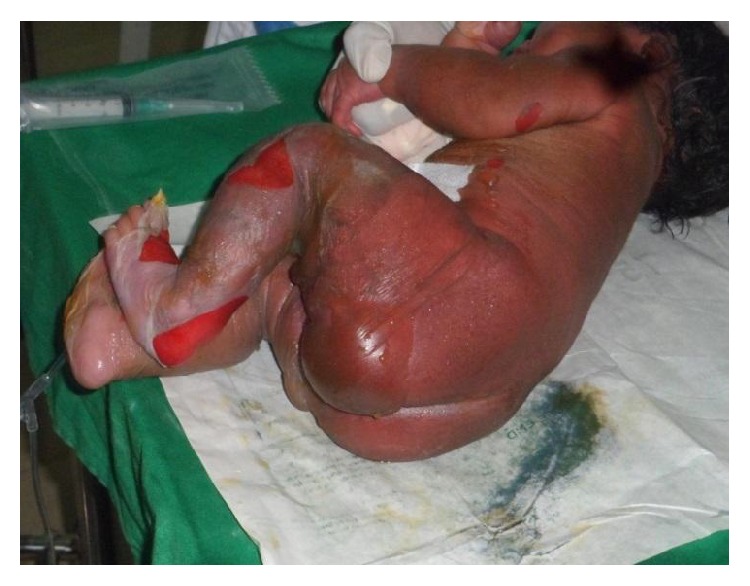Playlist
Show Playlist
Hide Playlist
Staphylococcal Scalded Skin Syndrome in Darker Skin: Epidemiology and Etiology
-
Slides Staphylococcal Scalded Skin Syndrome Epidemiology Etiology.pdf
-
Download Lecture Overview
00:01 Welcome to our lecture on staphylococcal scalded skin syndrome. 00:06 It's also known as Ritter disease or pemphigus neonatorum. This is superficial blistering skin disorder, which is caused by the exfoliative toxins of some strains of Staphylococcus aureus. 00:25 Neonates and infants are primarily affected, and about 45 cases per million children under the age of two. 00:33 It is also seen in adults with immunosuppression or renal failure, but the exotoxin producing strains of Staphylococcus aureus, most commonly phage group two strains 55 and 71, cause this condition. If we look at the pathophysiology, the exotoxin producing strains of staph aureus primarily infect the host. This can be skin infection, but also lung, heart infections as well. 01:04 These bacteria start producing exfoliative toxins A and B. These toxins enter the bloodstream and disseminate to the rest of the skin. 01:16 Once in the skin, these toxins bind to desmoglein 1. Desmoglein 1 is a key adhesion protein that links keratinocytes within the epidermis together. 01:30 So destruction of this desmoglein 1 induces loss of adhesion between the keratinocytes and then the keratinocytes separate. 01:40 And that phenomenon we call epidermolysis. 01:44 Then the space between these keratinocytes is filled with extracellular fluid which is transudate. And a superficial bullae then gets formed. On this slide here you can see the histological features of bulla in staphylococcal scalded skin syndrome, so it separates the cells of the stratum granulosum and the cells of the stratum corneum and lucidum. So how does this condition present? It starts with macula erythema on the skin folds, as listed here the neck axillae and inguinal folds. 02:28 This can be so subtle and difficult to appreciate in patients with highly pigmented skin. Pretty soon this evolves into a generalized erythema involving the whole body and the whole skin of the infant. 02:44 However, the palms, soles, and mucous membranes are usually spared. Later on as the disease progresses, erythematous patches develop into flaccid and ill-defined bullae. You can see on the right hand side how the epidermis is peeling off from the skin, as we have described on the histology. 03:11 Lastly, you get crusting and radial fissuring around the mouth, the nose and sometimes around the eyes. 03:22 You can see what I've just explained in the picture on the left, the crusting around the mouth and the nose and the peeling of the skin. 03:31 So some of the associated signs and symptoms include skin pain, fever, irritability of the infant, generalized weakness of the child, and very poor feeding. 03:45 What are some of the complications of SSS: loss of fluids and electrolytes leading to dehydration, hypothermia which is decreased temperature. 03:58 You may also get secondary infections, involving the lungs and, of course, cellulitis of the skin. 04:07 Scarring may be once sequelae if there's extensive involvement of the skin.
About the Lecture
The lecture Staphylococcal Scalded Skin Syndrome in Darker Skin: Epidemiology and Etiology by Ncoza Dlova is from the course Bacterial Skin Infections in Patients with Darker Skin.
Included Quiz Questions
What is the molecular target of exfoliative toxins A and B in staphylococcal scalded skin syndrome?
- Desmoglein 1
- Collagen type VII
- Laminin-332
- Integrin α6β4
- E-cadherin
Which anatomical sites are typically SPARED in staphylococcal scalded skin syndrome?
- Palms, soles, and mucous membranes
- Neck, axillae, and inguinal folds
- Face, especially around the mouth and nose
- Trunk and proximal extremities
- Scalp and posterior auricular regions
Customer reviews
5,0 of 5 stars
| 5 Stars |
|
5 |
| 4 Stars |
|
0 |
| 3 Stars |
|
0 |
| 2 Stars |
|
0 |
| 1 Star |
|
0 |




